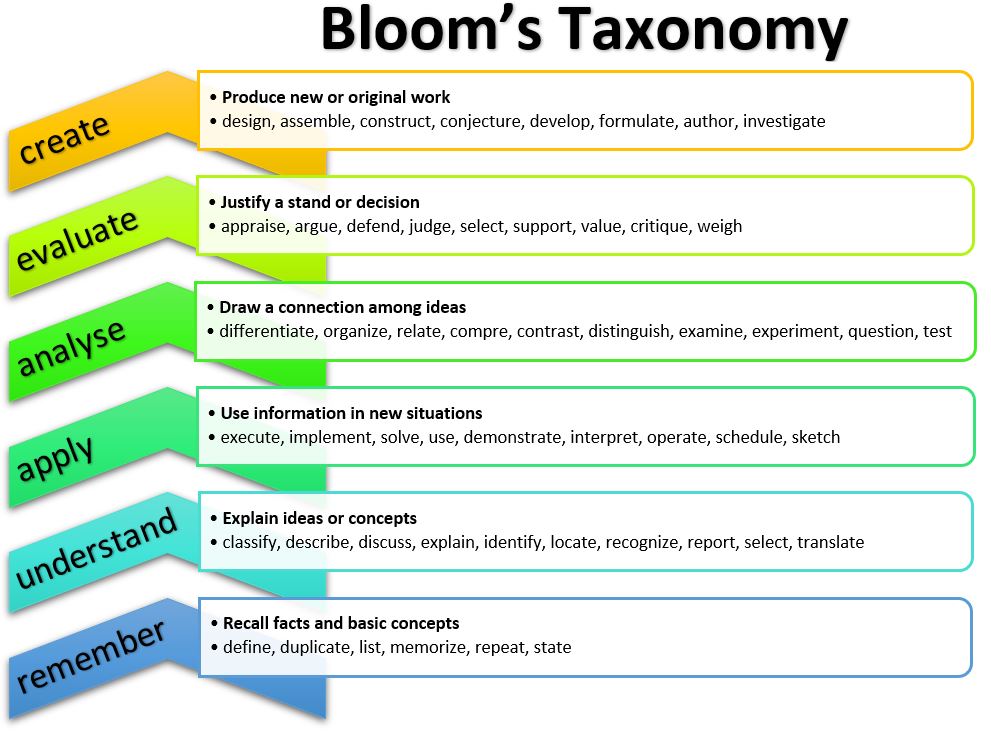1.1 Concepts of Learning
Concepts of learning can be found through a reflection on the mechanisms of how knowledge relates to realities in society. Within an educational framework, there tends to be three core concepts of learning: Constructivism, Bloom’s Taxonomy, and Epistemology. Throughout these concepts, the roots of the understanding of learning are present in the field of education, but also in other disciplines, including psychology, ethics, philosophy, and science.
Constructivism, in some cases, goes as far back as the German philosopher, Immanuel Kant; however, it is Carl Rogers who explains constructivism or constructive learning this way: “Every individual exists in a continually changing world of experience in which he [she] is the center[3].” Basic conceptualization is that knowledge. In the beginning, is subjective and constructed from perceptions about our society leading to mutually agreed-upon conventions. Constructivism attempts to strive for meaning, is social, and attempts to develop a personal understanding through reflection, analysis, and a gradual building of layers or depths of knowledge.
The role of constructivism in the framework of the teacher and students is for the teacher to allow the students to reflect on their subjective experiences toward some form of objective learning outcome. Through experience and reflection, students could then obtain a type of significant, or new knowledge that is quantifiably better than previously. Glasersfeld suggests the notion of radical constructivism in which all learning is constructed, and empirically, all humans organize learning[4]. Glasersfeld’s analysis of this notion suggests that the way learning can be acquired is subjective, but the concept of constructive learning and organization is objective.
Moving forward from construction, how might people organize their knowledge through a constructive model? Consider the cognitive tool of Bloom’s Taxonomy, which uses a set of three hierarchical levels of cognitive, affective, and psychomotor domains, and is one of the most recognized learning theories in the field of education. Bloom, Engelhart, Furst, Hill, and Krathwohl outline their goal of achieving these models through a biological lens of creating a taxonomy:
“…the use of the taxonomy as an aid in developing a precise definition and classification of such vaguely defined terms of ‘thinking’ and ‘problem solving’ would enable a group of schools to discern the similarities and differences among the goals of their different instructional programs.”[5]
The organization of the hierarchy is developed through a needs-based model and outlines baseline needs for baseline learning, eventually graduating to more focused and succinct objectives of analysis and creation.
For the third concept of learning, a foundation, or origin story needs to be understood regarding cognition and constructivism in order to comprehend the nation of knowledge. Epistemology is the rationalization and justification of knowledge, considering all factors of education, life, and society. This could also be traced back to Plato and his academy, but a more contemporary example would be from the ideas of John Locke, who suggests that knowledge is founded on the grounds of ideas and actions, which provide the innate ability of the human being to understand[6].
Smith, Babich, and Lubrick state that the scientific method of teaching creates an epistemological consensus through a level of empiricism and rationality[7]. Conceptualizing how people learn considers the epistemology and rational implications of a learning theory, or concept, that determines where the learning is coming from, and what the objective would be for the future.
With regard to learning, one factor that stands out is the behaviour of learning. Alexander, Schallert, and Reynolds conceptualize ‘questioning’ as being a constant dimension of the learning cycle[8]. De Houwer, Barnes-Holmes, and Moors define learning behaviour through changes on the scale of genetic adaptation and environmental changes[9]. Ultimately, learning is engaging and challenging. In order to understand learning theories and how they can be shaped in the classroom, these ideas need to be combined. Further, understanding how learning can be shaped requires cognizance of these concepts in order to develop a philosophy of teaching and learning.
New Way of Conceptualizing Learning
Different concepts of learning relate to the way it is being implemented in schools. Emily Boudreau, from the Harvard Graduate School of Education, proposed new modes of learning through experiential methods, such as gamifying education, storytelling, and moving the classroom outside of the walls of the school building[10]. Along with the different concepts, they need to be connected with effective modes of learning. This connects to the organizational hierarchy of Bloom’s Taxonomy which is described below in an interactive video. Use this video to compare your own learning, to the examples presented.


